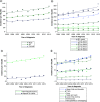Impact of rurality on melanoma diagnosis in Utah
- PMID: 34084450
- PMCID: PMC8162144
- DOI: 10.2217/mmt-2020-0023
Impact of rurality on melanoma diagnosis in Utah
Abstract
Aim: To analyze trends in Utah melanoma diagnosis and study the impact of rurality.
Patients & methods: State-wide melanoma incidence was calculated using Surveillance, Epidemiology, and End Results data (2005-2013). A subset of 5199 patients treated in an integrated healthcare system was further stratified for urban or rural residence.
Results: Early-stage tumors accounted for most of the increase in melanoma incidence over time. Age-adjusted melanoma incidence rate was higher in rural counties (46.7 vs 39.4). Anatomic site and stage did not differ between rural and urban patients. Rural patients were more commonly diagnosed by a local primary care provider.
Conclusion: Rurality had an impact on melanoma diagnosis in the specialty and location of the diagnosing provider.
Keywords: diagnosis; epidemiology; melanoma; oncology; prevention; skin.
© 2021 Tawnya L. Bowles.
Conflict of interest statement
Financial & competing interests disclosure This study is funded by Twine Clinical Consulting LLC (UT, USA). Utah Population Database is supported by NIH P30 CA2014. Utah Cancer Registry is supported by NIH Contract HHSN261201800016I and CDC Cooperative Agreement NU58DP0063200. TL Bowles is receiving time and effort support from Genentech for a melanoma prevention study and is the principal investigator for melanoma clinical studies sponsored by Amgen, Replimune and Polynoma. D Wray is a salaried employee of Twine Clinical Consulting LLC (Twine). Twine received grant funding from Genentech related to the work described herein. The authors have no other relevant affiliations or financial involvement with any organization or entity with a financial interest in or financial conflict with the subject matter or materials discussed in the manuscript apart from those disclosed. No writing assistance was utilized in the production of this manuscript.
Figures
References
-
- Mounessa JS, Caravaglio JV, Dellavalle RP. Comparison of regional and state differences in melanoma rates in the United States: 2003 vs 2013. JAMA Dermatol. 153(3), 345–347 (2017). - PubMed
-
• A nation-wide evaluation of melanoma incidence and death by state based on the Centers for Disease Control and Prevention Cancer Statistics database.
-
- U.S. Department of Health and Human Services, Centers for Disease Control and Prevention and National Cancer Institute. U.S. Cancer Statistics Working Group. U.S. Cancer Statistics Data Visualizations Tool, based on November 2017 submission data (1999–2015). (2018). http://www.cdc.gov/cancer/dataviz
-
- Jhappan C, Noonan FP, Merlino G. Ultraviolet radiation and cutaneous malignant melanoma. Oncogene 22(20), 3099–3112 (2003). - PubMed
-
- U.S. Geological Survey. Elevations and distances in the United States. General Information Product. (1991). http://pubs.er.usgs.gov/publication/70039194
-
- Utah Cancer Action Network. http://www.ucan.cc
LinkOut - more resources
Full Text Sources

